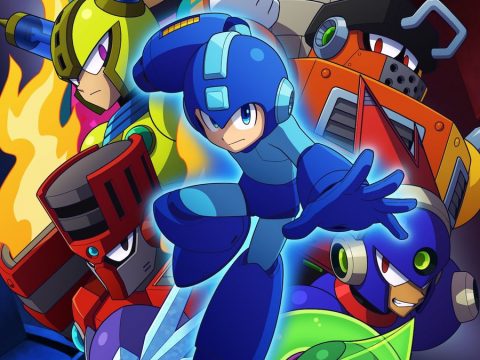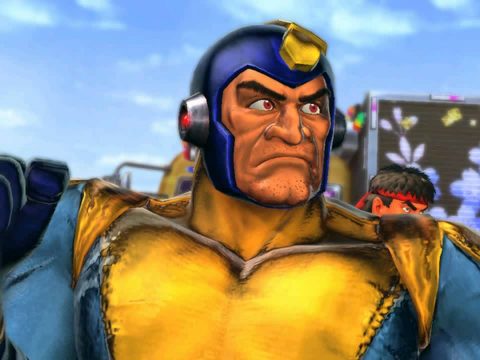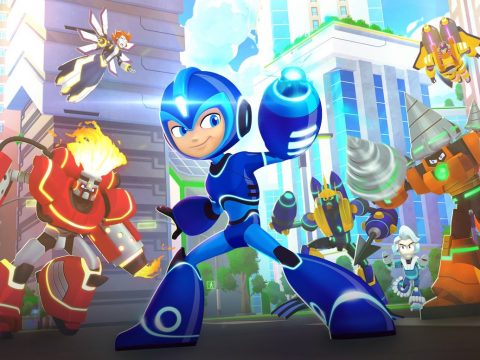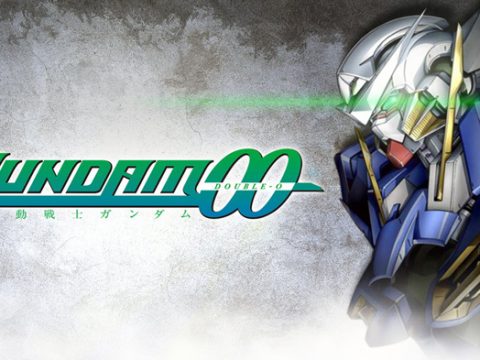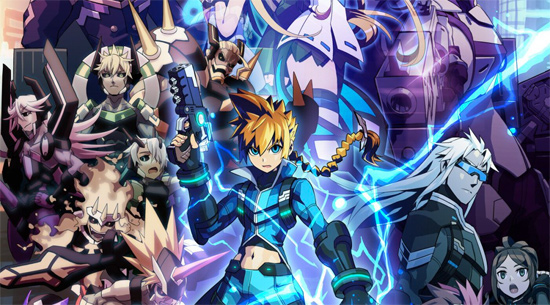
Azure Striker Gunvolt is basically a new Mega Man game. It was developed by Inti Creates, the guys responsible for the Mega Man Zero series, Mega Man 9, and Mega Man 10. It features a protagonist who dashes by pressing the L button, can ascend walls by jumping off them repeatedly, and fights through stages to a themed boss one at a time from a menu.
It’s Mega Man after Capcom apparently decided they didn’t want to make Mega Man games anymore. But is it any good? Well. Mostly.
Plotwise, Gunvolt mirrors some of the themes of the old X and Mega Man Zero games, replacing the robots with super-powered mutant humans under the employ of an evil corporation that effectively runs Cyberpunk Future Japan. The main character, a ponytailed teenager with the power of electricity named Gunvolt, is actually part of a terrorist organization aiming to take down the government, which is pretty crazy and daring. At least until an encounter with Shion, a little girl whose special brain power is summoning a virtual pop star, makes him decide to quit his job and settle down.
Or, I mean… sort of? He’s still in contact with his friends from the terrorist organization, and all of the missions in the game are effectively requests from his buddies to do exactly the same thing he was doing at the start of the game — go to place X, fight super-powered transforming crazy person Y. I don’t know.
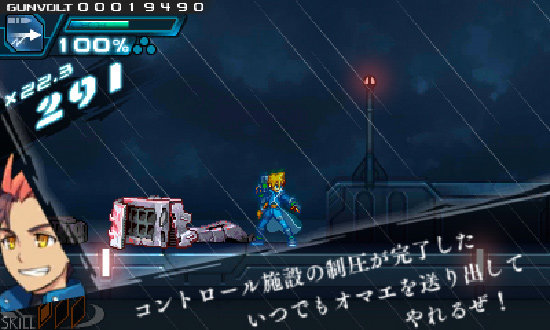
I wouldn’t normally spend this much time talking about the dumb plot in a game like this if the developers clearly didn’t want you to care so much about it. There’s voiced dialogue between GV and his pals in every stage, and the bosses talk, and talk, and talk, well beyond the point of distraction and into self-parody. This wouldn’t be a bad thing if the game didn’t present this to you with massive stylized text boxes that take up the entire bottom and left sides of the screen, even during boss fights where the left and right corners are insta-death kill pits that you kind of have to be able to see. You can disable all of this by pressing a button, but it’s almost like they kind of realized at the last second that the story presentation rendered the game borderline unplayable.
Thankfully, the play in Gunvolt is pretty good. Instead of shooting enemies like a Mega Man or cutting them in half with a sword like Zero, GV shoots enemies with low-damage darts to lock onto them and then hits them with auto-tracking lightning bolts to finish the job. The developers do a good job of exploring that design space over the course of the game: sometimes you have to lock on to multiple targets at once, or hit multiple parts of a boss at the same time to reveal a weakpoint. Deploying the electric field with the R button makes you fall slower than usual, allowing huge leaps over bottomless pits, or guided falls through corridors lined with spikes.

It’s a mechanic that blurs the line between long-range and close-range combat and feels like an attempt at bridging the gap between the different weapon playstyles in the Mega Man Zero games. Watching speedruns of those, you tend to see players ignore long-range weapons entirely, spending the whole game slashing enemies in the face, because really, why wouldn’t you?
That emphasis on close-range combat jived perfectly with what that series was about. They were fast and difficult games, and successfully cutting through enemies with Zero’s sword was satisfying on a visceral level while also being difficult to do, and mastering it slowly drew you towards the speedrun-oriented, high-risk core at the center of the game’s design.
Whereas Gunvolt is just… I don’t want to say the game’s not finished, but the central mechanic feels like it’s a revision or two away from being as satisfying as it should be. Playing the game well means taking your time to lock onto every enemy multiple times, zapping them with the R button, jumping at the last second to get an “Air-Hit” bonus, double-tapping down to recharge your electricity gauge, tapping the L button to cancel into a dash, and then rinsing and repeating until the end of the stage, where there’s a (pretty awesome) boss whose pattern you’ll memorize until you can do it without getting hit once.
That last part — the “not getting hit once” part — is maybe the worst thing about Gunvolt, depending on where you’re looking at it from. This is a game whose scoring system demands that you never get hit once. There’s nothing black or white about it. You accumulate points called “Kudos” by defeating enemies, but you don’t actually get those points until you either use one of your special skills by tapping the bottom screen or touch a checkpoint marker. Get hit by anything, and lose it all. This is especially painful when you hit 1000 Kudos, and suddenly a J-pop image song kicks in violently. “It’s on now,” the game is telling you, and if you mess up once? You’re back to 0, the song drops out, and you feel like a doofus.
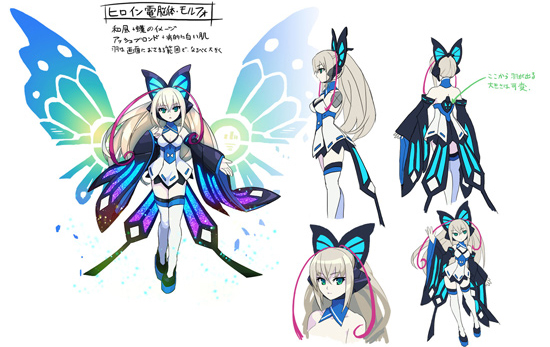
There’s an element of risk there that I like. Cash in your Kudos now by hitting the checkpoint, or hold off and wait for the next one, effectively doubling down on your investment? The recent Shovel Knight — another heir apparent to the throne of 80s Capcom action games — pulled a similar trick with its checkpoint system, but that felt like a concession to its players, while this feels like there’s only one right way to play the game, which is by ignoring all the checkpoints while never getting hit once. I’m not sure I like that.
At the same time, though, the game does a pretty good job of not making you feel like a complete idiot for choosing to play in a sub-optimal way. In the Zero games (and indeed, most of the original Mega Man games this is in many ways a spiritual successor to), not having enemy and boss patterns memorized meant dying over and over and over again until you did.
Gunvolt wants you to eventually get to that level, but it’s very easy to blunder your way through the game, barely learn boss patterns, score badly on every stage, and still clear the story with the best ending. You’re equipped by default with an item that prevents damage to you as long as you’re not electrocuting anything, which means you can get hit over and over again during stages and boss battles without ever coming close to death. You learn a number of special skills over the course of the game that deal ludicrous damage to bosses and enemies, GV levels up by collecting experience, and even on death, there’s a chance you’ll get resurrected and made effectively invincible based on how many times you chatted up Shion beforehand. They really want you to beat this game, guys.
There’s another weird feedback loop to the stages, wherein you level up, get items and materials based on how well you performed during the stage, build new items, and repeat, but it doesn’t actually work that great in practice. There’s no obvious rhyme or reason as to why you get certain materials, and the items you can build feel kind of pointless for the most part. If the game’s design clearly wants you to never get hit during a stage, and you don’t take that much damage from enemies to begin with, how useful is an item that “slightly reduces damage”? And how useful is the slightly improved version of that item you unlock immediately afterwards? On the other hand, the items that let you double jump and dash in the air, opening up entirely new ways to play the game, are so useful that you wonder why they bothered including other items at all, other than to give bored players something to busy themselves with while they… oh.
Gunvolt’s not a disaster, but it feels like a bunch of half-finished ideas that only manages to get by on the sheer competence of its execution. It’s a good Mega Man clone when I was expecting a great one. Damning with faint praise, I know. Hey, it’s got really cool boss fights!
Azure Striker Gunvolt
Platform: Nintendo 3DS and 2DS (eShop)
$14.99


